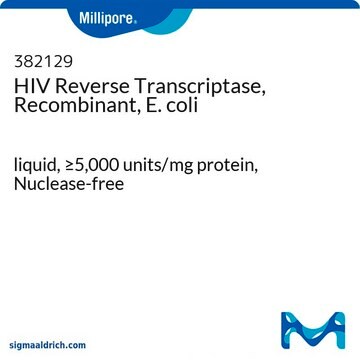ERT-RO
Roche
Expand™ Reverse Transcriptase
solution, recombinant, expressed in E. coli (AP401 (k)), sufficient for 20 reactions, sufficient for 100 reactions
Synonyme(s) :
reverse transcriptase, expand
About This Item
Produits recommandés
Produit recombinant
expressed in E. coli (AP401 (k))
Forme
solution
Utilisation
sufficient for 100 reactions
sufficient for 20 reactions
Conditionnement
pkg of 1,000 U (11785826001 [20 μl])
pkg of 5,000 U (11785834001 [100 μl])
Fabricant/nom de marque
Roche
Paramètres
42-43 °C optimum reaction temp.
Technique(s)
RT-PCR: suitable
RT-qPCR: suitable
Entrée
purified RNA
Méthode de détection
probe-based
Température de stockage
−20°C
Description générale
Spécificité
Reverse Transcriptase enzyme for RT-PCR reactions up to 3 kb
Application
Caractéristiques et avantages
- Obtain higher amounts of full-length cDNA transcripts and longer transcripts up to 13.5kb
- No RNase H activity
- Efficiently transcribes total RNA, mRNA, viral RNA and RNA rich in secondary structures
- Ideal for two-Step RT-PCR assay
- Purification of cDNA before PCR reaction is not necessary
Conditionnement
Définition de l'unité
Volume Activity: 50 U/μl
Autres remarques
Informations légales
Composants de kit seuls
- Expand Reverse Transcriptase 50 U/μl
- Expand Reverse Transcriptase Buffer 5x concentrated
- DTT Stock Solution 100 mM
Mention d'avertissement
Warning
Mentions de danger
Conseils de prudence
Classification des risques
Eye Irrit. 2
Code de la classe de stockage
12 - Non Combustible Liquids
Classe de danger pour l'eau (WGK)
WGK 1
Point d'éclair (°C)
does not flash
Certificats d'analyse (COA)
Recherchez un Certificats d'analyse (COA) en saisissant le numéro de lot du produit. Les numéros de lot figurent sur l'étiquette du produit après les mots "Lot" ou "Batch".
Déjà en possession de ce produit ?
Retrouvez la documentation relative aux produits que vous avez récemment achetés dans la Bibliothèque de documents.
Les clients ont également consulté
Contenu apparenté
RT-qPCR detects specific targets with applications in gene expression and pathogen detection.
La RT-qPCR, ou PCR quantitative après transcription inverse, combine les effets de la transcription inverse et de la PCR quantitative, ou PCR en temps réel, pour amplifier et détecter des cibles spécifiques. La RT-qPCR trouve de multiples applications, notamment dans la quantification du niveau d'expression génique, la validation de l'interférence par ARN ou la détection d'agents pathogènes comme les virus.
Notre équipe de scientifiques dispose d'une expérience dans tous les secteurs de la recherche, notamment en sciences de la vie, science des matériaux, synthèse chimique, chromatographie, analyse et dans de nombreux autres domaines..
Contacter notre Service technique














